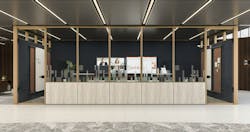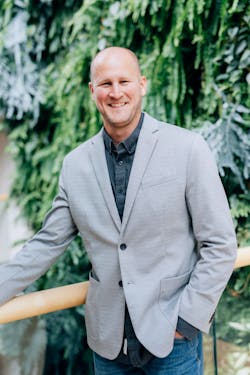Circularity in Furniture Manufacturing Makes Inroads in Commercial Interiors
Circularity: it’s the final frontier, as Captain Kirk said (sort of). It’s a future where the concept of waste has become a relic of the past and a closed-loop economy is not just policy, it’s a way of life.
We’re boldly going where no industry has gone before. Just as approaching the speed of light requires exponentially more energy for ever tinier increments of acceleration – to the point that the laws of physics (currently) say it’s just not physically possible – achieving true circularity requires equal parts science, energy and imagination.
We’ve surveyed three leading thinkers on the topic, each with a distinctively different take on our shared challenge. What will it take to bend our linear reality into a circle? Answers range from common sense to highly conceptual, but all agree that we’re at an all-hands-on-deck moment.
Here’s what they had to say:
Jarod Brames, director of sustainability, OFS Brands
Ultimate Circularity Means Biobased Materials
“I believe that ‘real’ circularity would require bio-based materials. This wouldn't just pertain to wood though. There are a lot of newer chemistries and materials out there, and more being developed, that could help to accelerate biobased and circular economies,” said Jarod Brames, director of sustainability for OFS.
“In nature, everything becomes a nutrient for something else. Nothing is wasted. I feel this is real circularity. Using materials that are natural and maybe ‘man-manipulated,’ but not man-made.
“At the end of the product's life there should be no concern over whether or not the product can be recycled, even if it can be. If you want to throw it away then it should break down into nutrient components that are conducive to other lifeforms and not pollutants or toxins. Then there is no break in the circle.
Brames foresees the industrial biotech industry introducing materials in the next few years that are produced through fermentation techniques and synthetic biology (manipulation of bacterial and yeast genetics), resulting in unique compounds with qualities that can benefit the building industry.
“You can have buyback and takeback programs; you can recycle aluminum; you can recycle plastics; but ultimately, you're still putting out a product that's made out of petroleum-based plastic or metal. You're just delaying the inevitable. It’s still going to end up with a linear death.”
One area Brames is watching closely is polymers produced organically, like chitin from mycelium. Chitin is the second most abundant biopolymer in the world, second only to cellulose from wood. It’s clear there is vast potential for replacing many of our materials with viable organic replacements. What’s not so clear is the timeline.
“I’m no synthetic biologist,” said Brames, “but I love following what’s going on in the synbio world. They
can take microorganisms, whether it's a bacteria or a yeast or whatever, manipulate that DNA to get it to do what they want it to do based off of the feedstock that they want to give it. They can introduce a genetically modified organism into a slurry of cellulose, which will ferment that cellulose into a new material.
“There are companies with databases of microorganisms that have been modified and tested to influence feedstocks in very specific ways. They’re already doing this to create certain kinds of medicines. It's just a matter of time until bioplastic alternatives are available with just the same qualities, if not better qualities, as petroleum-based plastics. And then the chair you're sitting in might have biobased plastic arms instead of petroleum based. I don't know the timeframe of that happening, but I would like to think it's going to be in the next five years.”
Brames points to viscose rayon as one example, although as in other biobased materials, some of these products still require chemical processes that are not entirely earth friendly. Another avenue being explored is mycelium-based media for 3D printers.
“Part of the reason why I feel so strongly about biobased product for true circularity is because with the nature of our industry, things don't change quickly. I don’t see us fixing the problem of the amount of materials going to the landfill in the near future. But if more of our materials are biobased, engineered to decompose and to not pollute or leach harmful chemicals that can get in the groundwater, they’ll decompose and become a nutrient for some other microorganisms.”
Brandi Susewitz, founder, Reseat
Streamlining the Second-Life Market
When you log on to Reseat.com, the first thing you see says it all:
“A little bit of forethought can end a lot of waste.”
Founder Brandi Susewitz had a visionary idea in 2000: a web-based marketplace that would help companies rehome their used office furniture.
“Then eBay happened, and they had a lot of funding, so I thought, ‘They’ll figure it out.’” So, she continued a successful career with commercial furniture dealerships in the San Francisco Bay area until Covid hit. With her sudden extra free time, she revisited the idea.
“I reached out to the EPA and found out that only 2% of contract furniture was actually being recycled or receiving a second life. Most of this furniture is less than 10 years old, because most leases are seven to 10 years. I was astounded. That's a multibillion-dollar untapped revenue stream sitting in our landfills, all because companies don't have a plan.
“The two things you need to know to keep contract furniture out of landfills are, one, an accurate inventory of what companies have, and two, time. If you call a used furniture broker with only eight weeks before the vacate date, they’re like a firefighter at a five-alarm blaze. Facilities managers, in charge of the building’s inventory, are mostly focused on getting into the new building. To sell what’s in the old building, they need to know what’s there.
“It’s an incredibly time-consuming task to identify every single piece of furniture in that building, measure it, photograph it, and then upload it to some kind of shared document,” said Susewitz. “So we created ‘Reseat ID,’ which acts as a passport that allows us to follow the lifecycle of the furniture.”
How it works: when a new item is sold, the dealer logs its unique ID into a database that becomes part of the purchasing company’s inventory management. When it comes time to sell, all the relevant info – including the product’s carbon footprint – is immediately available. This tool helps in the management of furniture inventories, allowing businesses to sell, move, reorder or donate their furniture efficiently.
This approach not only supports the circular economy but also offers practical solutions for businesses to manage their furniture assets.
“It’s actually a selling point for the dealers,” said Susewitz, “because it saves customers a lot of hassle for something they know they need to do. To further encourage participation, Reseat offers dealers a commission on the second lifecycle sale of that furniture.”
Reseat’s success was boosted by pending legislation in California requiring companies doing a certain amount of business in the state to start reporting their Scope 3 emissions in 2027.
“I call myself an accidental activist,” said Susewitz. “I know a lot about this industry, the products, the companies that use them, and how successful dealerships work. I also know maybe a little too much about how much waste we produce. I’m proud that we’ve created a solution based on a sustainable business model, and that it’s catching on.”
Heidi Frasure, sustainability manager for circular economy, Steelcase
Partnerships are Key
“We subscribe to the Ellen MacArthur Foundation definition of circularity, focusing on designing out waste in the first place,” said Heidi Frasure, sustainability manager for circular economy at Steelcase.
Steelcase is encouraging its design teams to design not only for longevity, but also toward designing for a reuse phase at the end of life to keep those materials in use for as long as possible.
“All of our design teams have targets for circularity, which means in addition to longevity we need to think about reconfigurability,” said Frasure. “One of the products that we've launched with this in mind is Everwall. It's an architectural wall solution that can be reconfigured over and over again. We’re looking at the data and running numbers on the lifecycle assessment to determine how much better the lifecycle impacts are versus traditional architectural solutions. Because it can be adapted and reconfigured for evolving needs, it can continue to have high-value life for that customer while keeping those same materials in use.”
Frasure also points to the Leap task chair, which contains 29% recycled content and is 93% recyclable.
“We're running currently a pilot in North America, where we're providing clients with like-new refurbished Leap chairs to tackle the issue of legacy furniture with an existing product that has value.
“And then there's a lot of focus on lowering embodied carbon, so we’re addressing that by adding in more recycled content. Not just ocean plastics, but looking at the landscape of high-quality recycled content, because we also have to address a lot of human-health criteria. We’ve made a lot of commitments around material chemistry, and not all recycled content is created equally. It’s a balancing act. But increasing recycled content will help lower products’ embodied carbon, so that's another huge focus right now for us.”
Frasure is careful to emphasize that when it comes to true circularity, no company operates in a vacuum.
“One thing that I don’t think is well understood: no one can do this on their own. It requires partnership, it requires collective action. Steelcase working alone is not going to move the needle. We have to leverage partnerships with remanufacturers, for example, or with end-of-use service who has experts in that field. We don't need to go and reinvent the wheel there. But we need to figure out how to nurture and leverage those partnerships, so that we're all working towards that collective good.”
About the Author

Kenn Busch
Contributing Editor
Kenn Busch is a longtime journalist, educator and public speaker dedicated to bridging the knowledge gap between materials, sustainability, and furniture and interior architecture. He is the founder of MateralIntelligence.com and ClimatePositiveNOW.org, two major resources for design and manufacturer specifiers.



